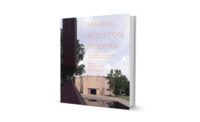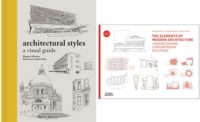In this book, preservationist Susan Benjamin and architect and historian Michelangelo Sabatino survey the classic 20th-century single-family homes that defined American Midwestern Modernism. Focusing on 53 projects in Chicago and its suburbs, it includes popular icons as well as many lesser-known houses that have faded from memory. The book begins with Howard T. Fisher’s “Ocean Liner” house (1929), in Winnetka, Illinois, which Henry Russell Hitchcock described as “nearly the first [house] in America to which the most rigid international standards of contemporary architecture criticism may be applied.” (Fisher’s firm would later serve as a training ground for architects like Lawrence Perkins and Philip Will—of Perkins and Will fame—and Edward Larrabee Barnes.) The survey ends with Stanley Tigerman’s “Hot Dog House” (1975), a playful weekend house for a young progressive Chicago couple.
Of course, several Frank Lloyd Wright and Mies van der Rohe houses are featured: the Kathryn Dougherty and Lloyd Lewis House (1939) and the Muirhead Farmhouse (1951) by Wright, and the Edith Farnsworth House (1951) and Isabella Gardner and Robert Hall McCormick III House (1952) by Mies. Both designers figure as the biggest influences on generations of Chicago architects. However, the book comes alive with less familiar gems: an early Bertrand Goldberg flat-roofed house (1936) that once appeared out of place in the mostly conservative Evanston neighborhood of Colonial- and Tudor-inspired cottages; an overlooked work by Le Roy Binkley, a student of Mies, who never received the recognition achieved by many of his contemporaries; or Bruce Goff’s eclectic Round House (1950) in Aurora, which incorporated materials like anthracite coal, steel, glass, cedar, and hemp. In each case, the authors briefly delve into the history of the house, the architect, the client, and even the house’s current condition, making you want more.
The authors also point out the dearth of research on the subject of single-family houses designed by female, Hispanic, Asian, and African American architects in Chicago during this period—something that only started to change by the late 1960s. They include a few examples, such as the 1954 Chicago house by the talented John W. Moutoussamy —a student of Mies who also designed the Johnson Publishing Company, the only downtown Chicago high-rise by an African American—and work by Jean Wiersema Wehrheim, one of the few women architects in the book, who designed more than 150 houses, mostly in the city’s western suburbs. There were other talented female architects who trained in Chicago but did not design houses in the city: Georgia Louis Harris Brown, for example, was a pioneering African American architect who practiced in Chicago during the 1940s and ’50s and is recognized as only the second African American woman licensed in the U.S. She left Chicago to practice in Brazil. Daisy Ruth Igel, who undertook advanced building research under Konrad Wachsmann as a student at IIT, also returned to Brazil to design splendid Modernist houses in Rio.
Reading this book, you begin to understand Wright and Mies’s huge influence on different generations of Chicago architects, but it is clear that Mies wins out, by the sheer number of projects showing his influence. The authors include on the book’s front cover Keck & Keck’s Maxine Weil and Sigmund Kunstadter House (1952), which was demolished in 2003, and the back cover depicts the Farnsworth House, which was saved by the preservation community that same year. It’s a clever but subtle warning to the reader that, for every house saved and being lovingly restored by a new generation of homeowners, there are still many threats of demolition to houses of that era.





Post a comment to this article
Report Abusive Comment